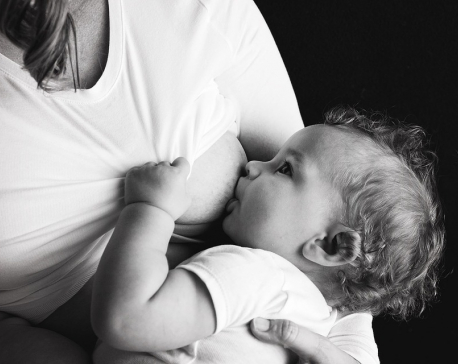
OR


Dr Pallavi Koirala
The author is a junior resident at College of Medical Sciences, Bharatpurkoiralapallu@gmail.com
The government should enhance an integrated approach to facilitate breastfeeding and remove all the barriers.
“Breastfeeding is an unsentimental metaphor for how love works, in a way. You don’t decide how much and how deeply to love you respond to the beloved, and give with joy exactly as much as they want.” -Marni Jackson
Being a mother of a toddler and having him breastfed exclusively, I can totally assimilate the sentiments expressed in the above quote.The rush of love that flows with your each drop, the surge of satisfaction you get when he lies in your chest is phenomenal.The feeling that your child is growing healthy because of you is really special. The emotional bond between the mother and the child is naturally created and it is irreplaceable
Breastfeeding is amazing for both mothers and babies. Considered as an ideal food for infants, it not only provides nutrients but also contains antibodies and immunoglobins that help them to fight against the diseases like diarrhea and pneumonia, thus enhancing their immunity.Evidences show that it boosts the children’s brain development and lowers the risk of diabetes and obesity. The World Health Organization(WHO) and United Nation Children’s Fund (UNICEF) strongly recommends that breastfeeding should be initiated within first hour of birth and continued exclusively for six months. From six months, it should be continued till the child reaches two years of age with other supplementary foods.
However, the fact remains that nearly two out of three infants are not breastfed exclusively for recommended six months and this rate has not improved in two decades.
The American Academy of Pediatrics (AAP) states that breastfeeding plays a role in prevention of SIDS (Sudden Infant Death Syndrome). Furthermore, it is beneficial for the mother as well for it helps in recovering easily from childbirth. It reduces the risk of breast and ovarian cancer, type II Diabetes and postpartum depression.
Barriers remain
Despite the multitude of benefits, many women in today’s world face multiple barriers in breastfeeding. Women who work after childbirth are less likely to continue breastfeeding due to short maternity leave which results in increasing the odds of not breastfeeding by 400 percent. Studies have shown that women who return to work after a year is more likely to discontinue breastfeeding than the women who are unemployed and work part time. Duration of maternity leave plays a huge role in the continuation of breastfeeding. Although breastfeeding is considered as normal, women and children both find it difficult if the proper breastfeeding technique is not applied. The incongruity between expectations about breastfeeding and the reality of the mother’s early experience with breastfeeding has been identified as a key reasonwhy many mothers stop breastfeeding within the first two weeks of postpartum.
Women suffering from problems like mastitis, sore nipples and pain during lactation, engorged breasts are less likely to continue breastfeeding unless they get any professional assistance. Many women are concerned about the fact that their infants are not getting enough supply of breast milk which consequently leads to early weaning of infants. In many cases, the perception of insufficient milk should be explained by the medical professionals. Health workers should explain to mothers the physiology of lactation, boost their confidence and encourage them to breastfeed.
Many traditional beliefs such as ‘big baby is healthy baby’ notion encourage parents to feed formula milk and solid food to the babies. Thus the knowledge of adequate baby weight and height of the child should be explained and the family members should be counseled in details.
Women are supposed to stop breastfeeding their children in public. This fear of being stigmatized causes many women to abandon breastfeeding and instead feed the formula milk. But with the support from the family and the community, interventions like group counseling, mass awareness, accessible breastfeeding facilities, immediate breastfeeding support by health care workers, breastfeeding rate can be increased by as much as by 86 percent and exclusive breastfeeding by 20 percent.
Greater good
To encourage mothers across the world to breastfeed, breastfeeding week is celebrated in the first week of August globally every year. In 2018, World Health Assembly endorsed World Breastfeeding Week as an important breastfeeding strategy. World Breastfeeding 2020 will focus on the impact of infant feeding on the environment/climate change and the imperative to protect, promote and support breastfeeding for the health of the planet and its people. The theme is aligned with Sustainable Development Goals-2030 campaign which highlights the links between breastfeeding and the environment/climate change.
The Baby friendly Hospital Initiative launched in 1991(BFHI) and updated in 2018 encourages the countries to achieve sustainable, universal coverage of breastfeeding interventions. A systematic review of BFHI in 19 countries showed that facilities adherence to BFHI’s 10 steps to successful breastfeeding can increase the rate of breastfeeding and early initiation of breastfeeding.
As per Nepal Demographic Health Survey 2016, 66 percent of children were exclusively breastfed for six months and about 55 percent werecolostrum fed within an hour of birth. In a study done in eight countries including Nepal, the reason behind the partial or improper feeding was found to be prelacteal feeding, discarding of colostrum and lack of knowledge in the first mother. This clearly shows the gap between the knowledge and practices in breastfeeding in our country. Early initiation of breastfeeding rate has significantly improved in only those countries with a large increases in institutional deliveries.
Nepal has initiated multiple programs for the promotion of breastfeeding. Nutrition Programs implemented by Family Welfare Division (FWD) Nutrition Section (1993-2018) plays a huge role in promoting breastfeeding as well as to counter malnutrition. Improving care and practices related to Infant and Young Child Feeding (IYCF) is a priority strategy of Ministry of Health and Population (MoHP).
However, gap remains between a province and another in adherence to breastfeeding. In FY 2017/18, for example, 42.5 percent of children were exclusively breastfed in Province 3 compared to only 7.1 percent of such children in Province 2. The national average was 29.6 percent, much less than the figure of 2016 Nepal Demographic and Health Survey (NDHS) which was 66 percent.
The government has introduced National Safe Motherhood Program to improve maternal and neonatal health through preventive and promotive activities. Programs like “Aama and Newborn” has been implemented to encourage women where the women are given incentives for the antenatal visits as well as for the institutional delivery. This program can definitely help in increasing the rate of breastfeeding in the future.
The government should enhance an integrated approach to facilitate breastfeeding and remove all the barriers. Long term plans and strategies should be made with annual evaluation to ensure progress. Monitoring the prevalence of breastfeeding and planning the actions accordingly, educating the mother and family about the importance of breastfeeding in the hospitals, enhancing quality care in health facilities, strengthening the links between the health facilities and communities, building breastfeeding zones in every mall, domestic and international airports and raising mass awareness will be vital for promoting breastfeeding.
To increase the rate of breastfeeding is not the sole responsibility of the mother. It is a combined responsibility of the family members, communities, medical professionals and policy makers. All need to work together for this cause.
The author is a junior resident at College of Medical Sciences, Bharatpur
koiralapallu@gmail.com
You May Like This

World Breastfeeding Week 2019 begins with slogan 'Empower parents, enable breastfeeding’
KATHMANDU, Aug 1: Every year, World Breastfeeding Week(WBW) is celebrated from August 1 to August 7 throughout the world. ... Read More...

Lavrov underlines importance of helping Syria in reconstruction
MOSCOW, July 23: Russian Foreign Minister Sergey Lavrov underlined the importance of helping Syria in the reconstruction of the country... Read More...

Across all barriers
Sandhya Yonzon was 28 years old when she accepted a ring from her boyfriend. When she did, she had no... Read More...









Just In
- Forced Covid-19 cremations: is it too late for redemption?
- NRB to provide collateral-free loans to foreign employment seekers
- NEB to publish Grade 12 results next week
- Body handover begins; Relatives remain dissatisfied with insurance, compensation amount
- NC defers its plan to join Koshi govt
- NRB to review microfinance loan interest rate
- 134 dead in floods and landslides since onset of monsoon this year
- Mahakali Irrigation Project sees only 22 percent physical progress in 18 years









Leave A Comment